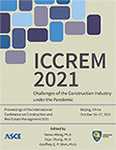Modeling Linear Schedules under Uncertain Scope of Work Conditions with Singularity Functions
Publication: ICCREM 2021
ABSTRACT
Construction projects face uncertainty in terms of scope of work during their execution. This uncertainty can lead to changes in the amount of work, and ultimately result in delays. This paper presents a mathematical model based on singularity functions that improves the Linear Scheduling Method (LSM) by accounting for scope of work uncertainty. The contribution of this model is twofold: first, it allows for an explicit representation of scope of work uncertainty in the LSM’s mathematical equations; and second, it evaluates and visualizes the effects of this uncertainty on the schedule. The model can assist decision makers in making rational decisions for the planning and control of projects under uncertain scope of work conditions.
Get full access to this article
View all available purchase options and get full access to this chapter.
REFERENCES
AbouRizk, S. M. (2010). “Role of simulation in construction engineering and management.” Journal of Construction Engineering and Management, 136(10), 1140–1153.
Atkinson, R., Crawford, L., and Ward, S. (2006). “Fundamental uncertainties in projects and the scope of project management.” International journal of project management, 24(8), 687–698.
Campbell, K., Clegg, D. R., Perera, T., Stephenson, P., and Stevens, A. (1997). “Simulation in the construction industry - a case-study review.” Proceedings of 13th Annual ARCOM Conference, London, U.K., 408–417.
Douglas, D. E. (1978). “PERT and simulation.” Proceedings of the 10th conference on Winter simulation, 89–98.
Ioannou, P. G., and Martinez, J. C. (1996). “Comparison of construction alternatives using matched simulation experiments.” Journal of Construction Engineering and Management, 122(3), 231–241.
Jato-Espino, D., Castillo-Lopez, E., Rodriguez-Hernandez, J., and Canteras-Jordana, J. C. (2014). “A review of application of multi-criteria decision making methods in construction.” Automation in Construction, 45, 151–162.
Kamat, V. R., and Martinez, J. C. (2008). “Software mechanisms for extensible and scalable 3D visualization of construction operations.” Advances in Engineering Software, 39(8), 659–675.
Katsuragawa, C. M., Lucko, G., Isaac, S., and Su, Y. (2021). “Fuzzy linear and repetitive scheduling for construction projects.” Journal of Construction Engineering and Management, 147(3), 04021002 (13).
Kelley, J., and Walker, M. (1959). “Critical-path planning and scheduling.” Proceedings of the eastern joint computer conference, Boston, U.S., 160–173.
Lucko, G. (2009). “Productivity scheduling method: linear schedule analysis with singularity functions.” Journal of Construction Engineering and Management, 135(4), 246–253.
Lucko, G. (2011). “Integrating efficient resource optimization and linear schedule analysis with singularity functions.” Journal of Construction Engineering and Management, 137(1), 45–55.
Malcolm, D. G., Roseboom, J. H., Clark, C. E., and Fazar, W. (1959). “Application of a Techinque for Research and Development Program Evaluation.” Operations Research, 7(5), 646–669.
Martinez, J. C. (2001). “EZStrobe - general - purpose simulation system based on activity cycle diagrams.” Proceeding of the 33rd Winter Simulation Conference, Arlington, U.S., 1556–1564.
Martinez, J. C., and Ioannou, P. G. (1995). “Advantages of the activity scanning approach in the modeling of complex construction processes.” Proceedings of the 27th Winter Simulation Conference, Arlington, U.S., 1024–1031.
Oliveros, A. V. O., and Fayek, A. R. (2005). “Fuzzy logic approach for activity delay analysis and schedule updating.” Journal of Construction Engineering and Management, 131(1), 42–51.
Su, Y., and Lucko, G. (2015). “Synthetic cash flow model with singularity functions i: theory for periodic phenomena and time value of money.” Journal of Construction Engineering and Management, 141(3), 04014078(12).
Van Slyke, R. M. (1963). “Letter to the editor: Monte Carlo methods and the PERT problem.” Operations Research, 11(5), 839–860.
Yang, I.-T. (2006) “Using Gaussian copula to simulate repetitive projects.” Construction Management and Economics, 24(9), 901–909.
Information & Authors
Information
Published In
Copyright
© 2021 American Society of Civil Engineers.
History
Published online: Dec 9, 2021
Authors
Metrics & Citations
Metrics
Citations
Download citation
If you have the appropriate software installed, you can download article citation data to the citation manager of your choice. Simply select your manager software from the list below and click Download.
